Who was Rachel Carson?
Rachel Carson (1907-1964) is perhaps the finest nature writer of the 20th Century.
What did Rachel Carson do that was so important?
Rachel Carson is remembered more today as the woman who challenged the notion that humans could obtain mastery over nature by chemicals, bombs and space travel than for her studies of ocean life.
Her sensational book Silent Spring (1962) warned of the dangers to all natural systems from the misuse of chemical pesticides such as DDT, and questioned the scope and direction of modern science, initiated the contemporary environmental movement.
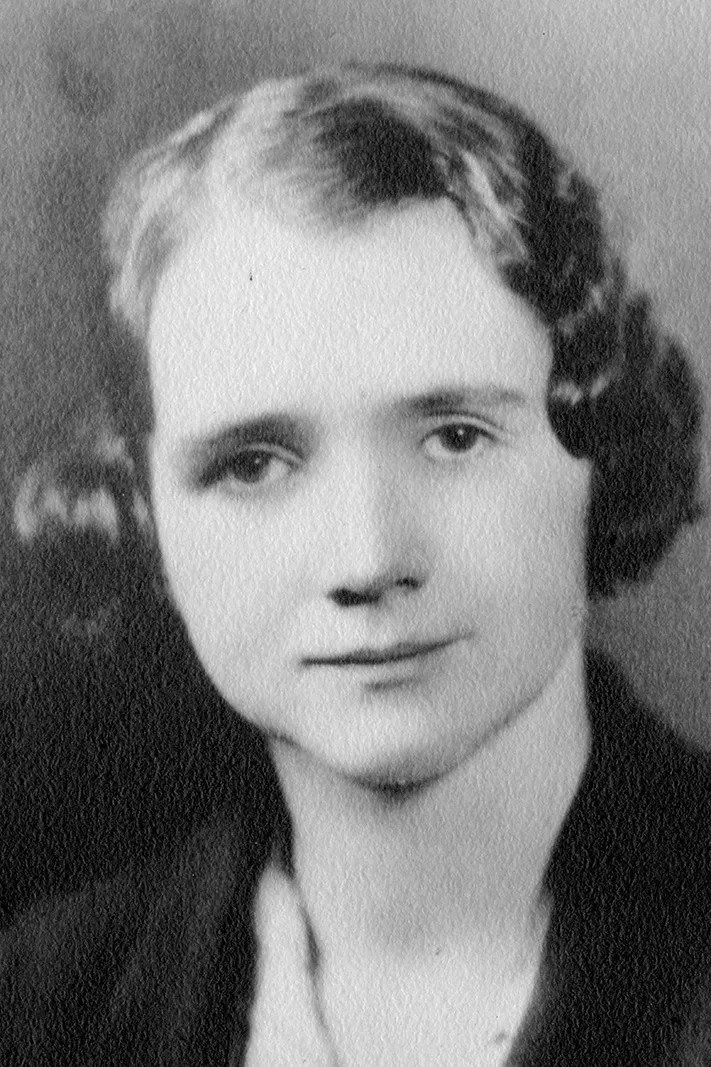
When and where was Rachel Carson born?
Rachel Louise Carson was born on the 27th May 1907 on a family farm near Springdale Pennsylvania, to parents Maria Frazier McLean and Robert Warden Carson.
She had two older siblings, Marion born 1898 and Robert McLean 1899.
Rachel spent a lot of her time exploring the family farm, she was also enthusiastic about reading.
She enjoyed the works of Beatrix Potter and as she moved into her teens, Herman Melville, Joseph Conrad and Robert Louis Stevenson were among her favourite authors.
When did Rachel Carson start writing?
Rachel Carson began writing at the age of eight and had her first story published in the St. Nicholas Magazine (a popular monthly American children's magazine, founded in 1873) in 1918 when she was 11.
Rachel, attend Parnassus high school in Pennsylvania and graduated in 1925 at the top of her class.
What did Rachel Carson study at university?
From 1925-1929 Rachel attends Pennsylvania College for Women, initially studying English.
However, in 1927 she changed her major to biology and graduates Magna Cum Laude.
Rachel won a summer scholarship to the Woods Hole Marine Biological Laboratory at Woods Hole, Massachusetts.
From 1929-1932 Rachel studies at Johns Hopkins University Department of Zoology. She had an internship in 1931 with Raymond Pearl’s Institute for Biological Research, School of Hygiene and Public Health, Genetic research.
Her MA Degree was awarded in 1932, her thesis was titled: "The Development of the Pronephros During the Embryonic and Early Larval Life of the Catfish”.
Rachel Carson's early career

In 1934 Rachel was forced to leave Johns Hopkins to seek employment to help her family during the Great Depression.
In 1935 the family’s financial situation worsened when her father died suddenly, leaving Rachel to care for her ageing mother.
Rachel took up a temporary position at the U.S. Bureau of Fisheries, where she would write copy for a radio series, Romance Under the Waters.
Romance Under the Waters was a weekly educational series spanning 52 weeks. It focused on the aquatic life and intended to generate public interest in fish biology.
Rachel also began submitting article to local publication based on her research for the series.
Following the success of the series Rachel was asked to write the introduction to a U.S. Bureau of Fisheries brochure.
After passing her civil service exam, out scoring all other applicants, Rachel secured a full-time post in 1936 as a junior aquatic biologist. She became only the second women to be hired in a full-time professional role by the U.S. Bureau of Fisheries.
Her main responsibilities were to analyse and report data on fish populations and write literature for the public. She was also writing articles for The Baltimore Sun based on her research and discussions with marine biologists.
In the January of 1937 her sister died leaving Rachel the sole breadwinner, looking after her mother and two nieces.
In July 1937 Rachel had an essay Undersea published in the Atlantic Monthly, this was a revised edition of The World of Waters originally wrote for her first fisheries bureau brochure.
Following interest from publishing house Simon & Schuster and several years of writing it became Rachel's first book, Under the Sea-Wind. Although it received excellent reviews it sold poorly, however in later years it become a best seller.
Rachel rose within the ranks of the United States Fish and Wildlife Service (formally the U.S. Bureau of Fisheries) in 1945 becoming a supervisor of a small writing team, it was around this time that she first encountered the subject of DDT.
In 1949 she became chief editor of publications, this new position allowed her to spend more time in the field and freedom in choosing her writing projects.
By this time she had started working on material for her second book, and also had made a conscious decision to begin a transition into full-time writing.
When did Rachel Carson write The Sea Around Us?
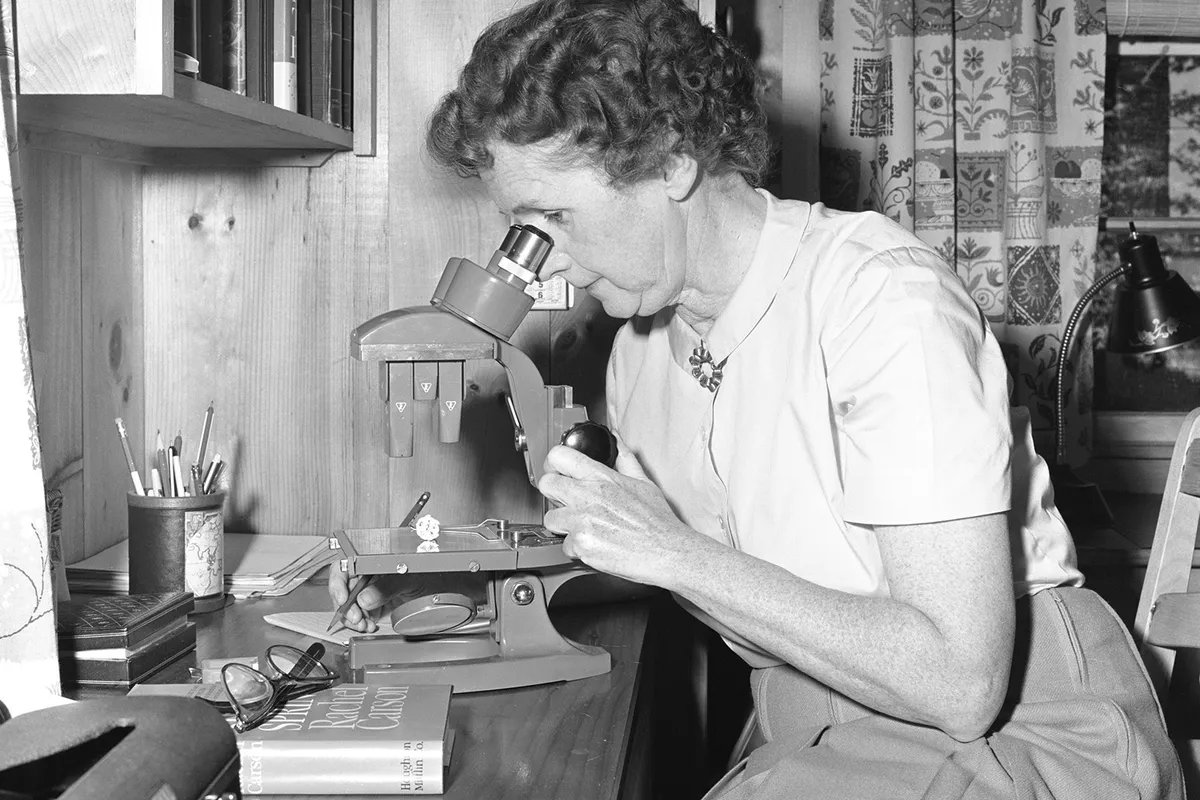
Rachel's second book The Sea Around Us was published on the 2nd July 1951, By Ford University Press.
Several chapters appeared in the Science Digest and The Yale Review, one of the chapters 'The Birth of an Island' won the American Association for the Advancement of Science's George Westinghouse Science Writing Prize.
Nine chapters were serialised in the The New Yorker, in June, prior to the publication of the book.
The book was in the New York Times Best Seller List for 86 weeks, and Rachel received two awards for it. Because of the success of the book Rachel was two honorary doctorates.
Due to the success of The Sea Around Us her first book, Under the Sea-Wind was republished and became a best seller.
This also provide Rachel with financial security allowing her to give up her job and become a full time writer.
Rachel licensed a documentary film based on the book, however she was not happy with the script by writer, producer and director Irwin Allen.
Saying it was scientifically embarrassing and didn't portray the atmosphere of the book.
Although she had the rights to review the script, she had no say over the final content. This lead too many scientific inconsistencies within the documentary.
However it went on to win the 1953 Academy Award for Best Documentary Feature.
The whole experience left Rachel embittered resulting in her never selling any further film rights to her work.
Rachel Carson's friendship with Dorothy Freeman
Rachel first met Dorothy in the summer of 1953 following Dorothy writing to Rachel welcoming her to the area. This was to become a friendship that lasted until Rachels death.
Their relationship was mainly conducted through letters and time spent together during summer.
The two discovered a shared love for the natural world. Their descriptions of the arrival of spring or the song of a hermit thrush are lyrical and their friendship quickly blossomed, as each realised she had found in the other a kindred spirit
During their friendship they would exchange about 900 letters. Due to the content of the letters some questioned the nature of their friendship.
Such content was:
- Rachel: "But, oh darling, I want to be with you so terribly that it hurts!”
- Dorothy: “I love you beyond expression... My love is boundless as the Sea.”
- Rachel in her last letter: Never forget, dear one, how deeply I have loved you all these years."
Shortly before Rachel's death hundreds of these letters were destroyed.
The remainder, about 750 letters, were later published in 1995 in a book entitled Always, Rachel: The Letters of Rachel Carson and Dorothy Freeman, 1952–1964: An Intimate Portrait of a Remarkable Friendship.
The book was edited by Dorothy's granddaughter, Martha Freeman.
Linda Lear, Rachel Carsons biographer said of the book:
To read this collection is like eavesdropping on an extended conversation that mixes the mundane events of the two women's family lives with details of Carson's research and writing and, later, her breast cancer.
Readers will inevitably wonder about the nature of the women's relationship; editor Martha Freeman, Dorothy's granddaughter, believes that the correspondents' initial caution regarding the frankly romantic tone of their letters led them to destroy some.
Whether the relationship was sexual, theirs was a deeply loving friendship, and reading their letters leaves a sense of wonder that they felt so free to give themselves this gift.
Please note that external videos may contain ads
Rachel Carson | American Experience | PBS
The Edge of the Sea
The third volume of her sea trilogy, The Edge of the Sea, was completed in 1955.
The Edge of the Sea focused on life in the coastal ecosystems, particularly of that along the Easter Seaboard
It was published on the 26th October of that year, shortly before publication it was condensed into two instalment in the New York Times.
Again, like The Sea Around Us, it received positive reviews if quite not as enthusiastic.
Around the mid 1950's Rachel's interests were turning towards conservation, she became involved with several conservation groups including The Nature Conservancy.
Early on 1957, one of Rachel's nieces died at the age of 31, leaving her son, Roger an orphan. As well as already taking care of her ageing mother Rachel adopted Roger, taking on even more responsibilities.
Towards the end of 1957 she was closely following the proposed use of widespread pesticide spraying; including that of the United States Department of Agriculture (USDA) who planned to eradicate fire ants.
Spraying programs were on the rise, particularly using chlorinated hydrocarbons and organophosphates.
For her remaining years Rachel's main professional focus would be the dangers of pesticide overuse.
Silent Spring

Silent Spring began with a “fable for tomorrow” – a true story using a composite of examples drawn from many real communities where the use of DDT had caused damage to wildlife, birds, bees, agricultural animals, domestic pets, and even humans.
Rachel used it as an introduction to a very scientifically complicated and already controversial subject.
This “fable” made an indelible impression on readers and was used by critics to charge that Rachel was a fiction writer and not a scientist.
Serialised in three parts in The New Yorker, where President John F. Kennedy read it in the summer of 1962.
Silent Spring was published in August and became an instant best-seller and the most talked about book in decades.
Utilising her many sources in federal science and in private research, Carson spent over six years documenting her analysis that humans were misusing powerful, persistent, chemical pesticides before knowing the full extent of their potential harm to the whole biota.
Rachel’s passionate concern in Silent Spring is with the future of the planet and all life on Earth. She calls for humans to act responsibly, carefully, and as stewards of the living earth.
Additionally Silent Spring suggested a needed change in how democracies and liberal societies operated so that individuals and groups could question what their governments allowed others to put into the environment.
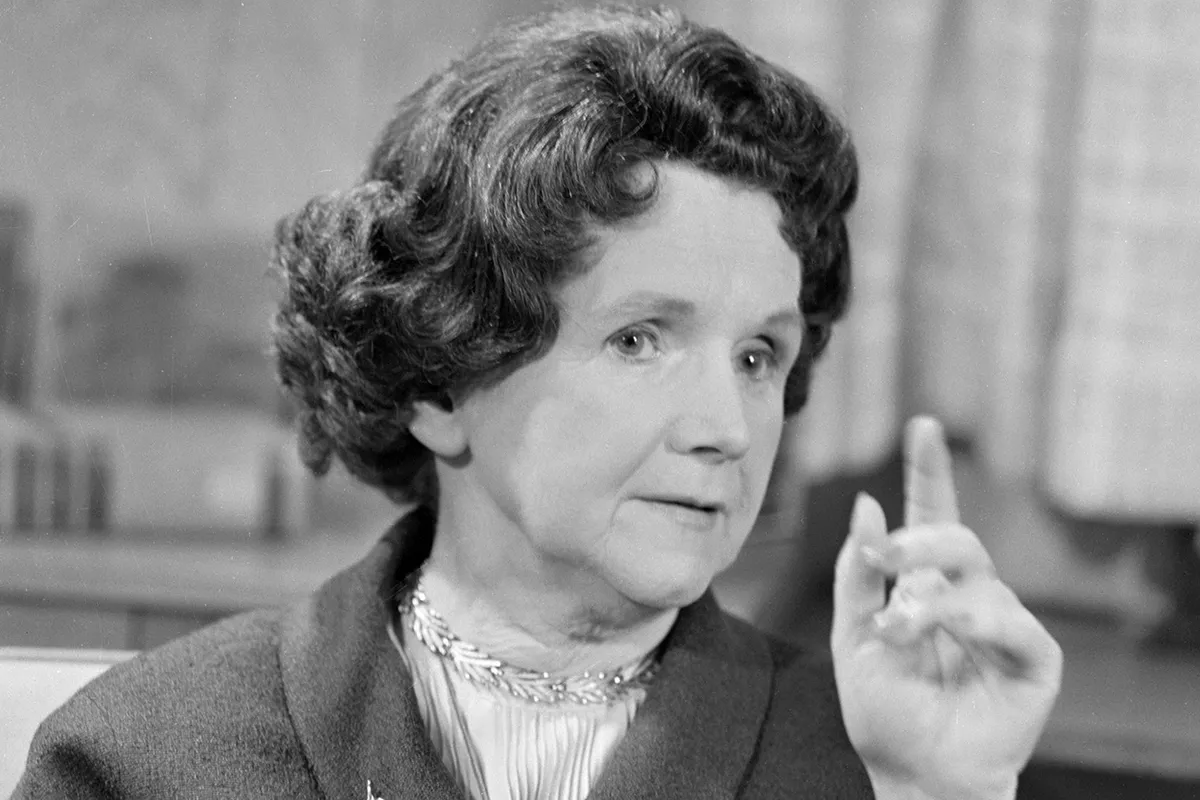
Far from calling for sweeping changes in government policy, Rachel believed the federal government was part of the problem.
She admonished her readers and audiences to ask “Who Speaks, And Why?” and therein to set the seeds of social revolution.
She identified human hubris and financial self-interest as the crux of the problem and asked if we could master ourselves and our appetites to live as though we humans are an equal part of the earth’s systems and not the master of them.
Rachel expected criticism, but she did not expect to be personally vilified by the chemical industry and its allies in and out of government.
She spent her last years courageously defending the truth of her conclusions until her untimely death in 1964.
Silent Spring inspired the modern environmental movement, which began in earnest a decade later. It is recognised as the environmental text that “changed the world”.
She aimed at igniting a democratic activist movement that would not only question the direction of science and technology but would also demand answers and accountability.
Rachel Carson was a prophetic voice and her “witness for nature” is even more relevant and needed if our planet is to survive into a 22nd century.
Rachel was attacked by the chemical industry and some in government as an alarmist, but courageously spoke out to remind us that we are a vulnerable part of the natural world subject to the same damage as the rest of the ecosystem.
Testifying before Congress in 1963, Carson called for new policies to protect human health and the environment.
Please note that external videos may contain ads
Pesticides - DDT - Rachel Carson - Silent Spring | NV atCEPImperial
When did Rachel Carson die?
In January Rachel was bedridden for weeks due to having a duodenal ulcer followed by several infections.
Just as she was beginning to make a full recovery, in March she found cysts in her left breast. This lead to her having a mastectomy, which her doctor described as precautionary and no other treatment was needed.
By December Rachel discovered that the tumour was malignant and the cancer had metastasised.
In January 1964 Rachel became ill with a respiratory virus, she was already weakened from both her breast cancer and the effects from her treatment.
Rachel’s health continued to deteriorate and in February she was also diagnosed with server anaemia caused by her radiation treatment.
In March her cancer had spread to her liver.
On the 14th of April 1964 Rachel Carson passed away at the age of 58, from a combination of cancer and heart failure, at her home in Silver Spring, Maryland.
Following her cremation Rachel’s ashes were divided in two.
Half of the ashes were buried beside her mother at Parklawn Memorial Gardens, Rockville, Maryland, due the insistence of her Robert.
While her remaining ashes, according to Rachel's final wishes, were scattered along the coast of Southport Island, near Sheepscot Bay, Maine, this was carried out by Dorothy Freeman.
Posthumous honours
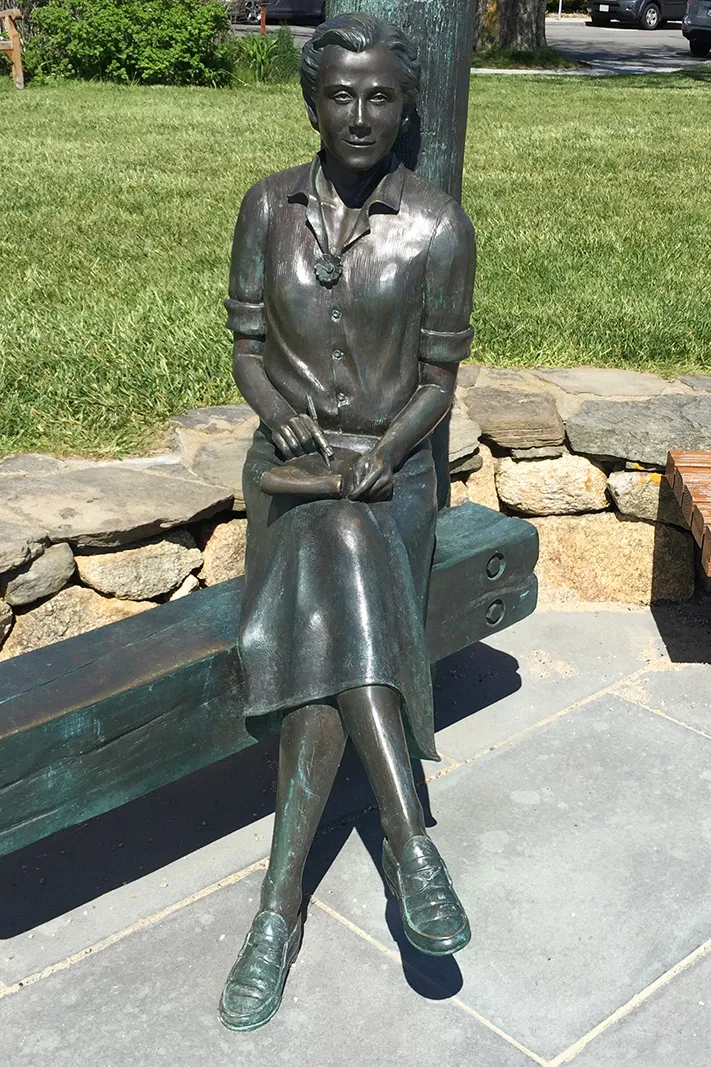
Rachel Carson has received numerous posthumous honours from groups around the world such as government institutions, conservations organisations and educational institutes.
One of the most significant has to be the Presidential Medal of Freedom, this is the highest honour that can awarded to a civilian in the United States. This honour was bestowed to Rachel on the 9th of June 1980.
In 1973 Rachel was inducted into the National Women’s Hall of Fame, an American institute founded in 1969.
Rachel’s childhood home in Springdale, Pennsylvania, now known as the Rachel Carson Homestead, became a National Register of Historic Places site, meaning it is worthy of preservation due its historical significance.
There are also several statues of Rachel, one of which is an outdoor sculpture depicting Rachel sitting on a bench which was installed on July 14th 2013 at the Waterfront Park in Woods Hole, Massachusetts, United States.
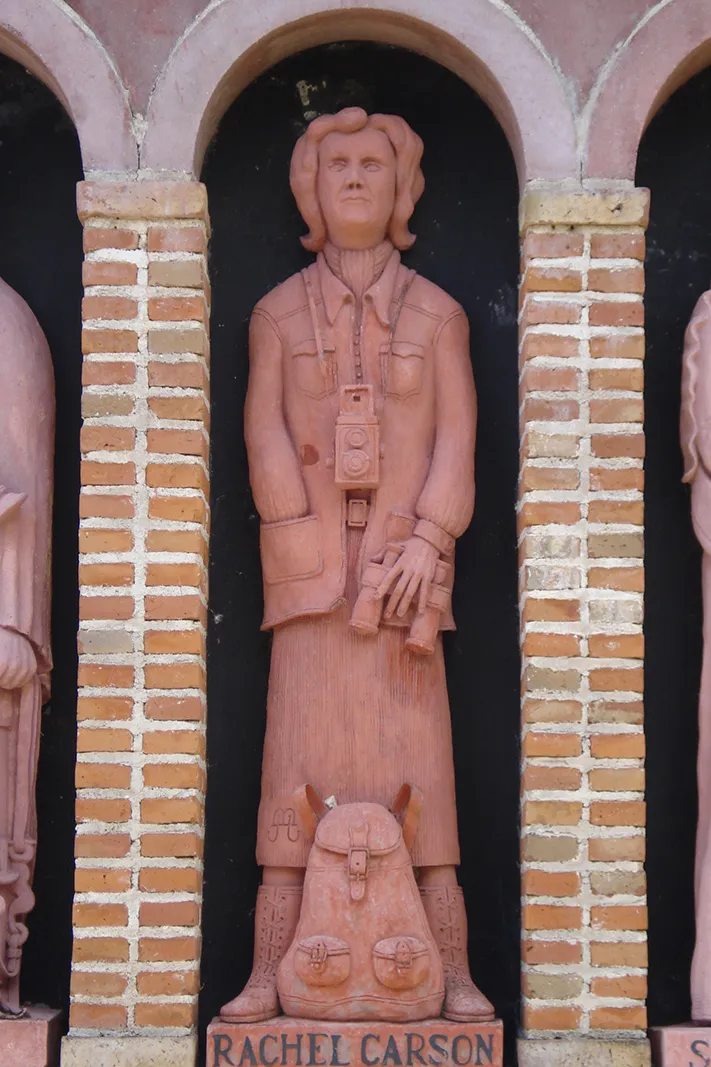
Her statues are not limited to the USA, at the Rocsen Museum, Nono, Córdoba Province, Argentina, she is one of 49 statues guarding the facade.
Other honours include:
- Research vessels named after her
- Educational places named in her honour
- Rachel Carson Prize
- Rachel Carson Book Prize
Silent Spring Institute
In 1994, the Silent Spring Institute was founded, it was so named to honour Rachel Carson.
It is the leading scientific research organisation dedicated to uncovering the links between chemicals in our everyday environment and women’s health, with a focus on breast cancer prevention.
Books by Rachel Carson
During her life Rachel had 4 books published all going on to become ‘best sellers’. Each book in some way changed the way we thought about ourselves and our world. They are still in print.
Under the Sea-Wind (Originally published in 1941)
In Under the Sea-Wind Rachel wrote of what life lived on or under the sea was like for three different creatures.
It is a celebration of ecology and how life in the open sea is shared and how each creature contributes to the whole.
It was inspired by Carson’s love of the mysterious and the wonder-full. Her personal favourite of all her books, it marked the debut of one of the finest nature writers in the twentieth century and a scientist whose ability to see and to imagine life "Under the Sea-Wind" ultimately changed how we view our relationship with the natural world.
The Sea Around Us (Originally published in 1951)
The Sea Around Us is based on post World War II geographical and oceanographic evidence of the life and work of the sea.
It is a study of the processes that formed the earth, the moon, and the oceans. It won the National Book Award in 1952 and made Carson an international voice for the public understanding of science.
The Edge of the Sea (Originally published in 1955)
The Edge of the Sea is a practical guide to identifying the inhabitants of the sea that are found in marshes, tide pools, and shallows that border it - a world that mirrors the "spectacle of life in all its varied manifestations as it has appeared, evolved, died out."
In it Carson considers the tide lines of the eastern sea coast -- the rocky shores, the sandy dunes, and the coral reefs.
Silent Spring (Originally published in 1962)
The 40th and 50th Anniversary Edition of Silent Spring includes a new introduction by Linda Lear and an afterword by E.O. Wilson. See why Carson's analysis is more relevant now than ever.
There were 2 further books published following Rachel’s death which were based on her writings.
The Sense of Wonder (Originally published in 1965)
The Sense of Wonder, originally written as a 1950's magazine article ("Help Your Child to Wonder") and photo-illustrated after her death, details Carson's philosophy that adults need to nurture a child's inborn sense of wonder about the natural world.
The new edition with glorious photographs by Nick Kelsh, printed in Italy, is the beautiful kind of book Carson imagined might someday be printed. Linda Lear wrote the introduction.
Lost Woods: The Discovered Writing of Rachel Carson
- Originally published in 1998
- Edited with an introduction by Linda Lear
This collection of childhood prose, early writings, intimate letters, speeches, a TV script, and unpublished fragments by one of the pioneers of the modern environmental movement gives rare glimpses of Carson’s unique capacity to fuse scientific precision and lyrical power.
Spanning forty-five years of Carson’s writing it constitutes a stirring autobiography of the scientist who taught the world about ecology.
Books about Rachel Carson
Rachel Carson: Witness for Nature
- Author: Linda Lear
- Originally published in 1997
This definitive, sweeping biography shows the origins of Carson's fierce dedication to natural science -- and tells the dramatic story of how Carson, already a famous nature writer, became a brilliant if reluctant reformer.
Drawing on unprecedented access to sources and interviews, Lear masterfully explores the roots of Carson's powerful connection to the natural world, crafting a " fine portrait of the environmentalist as a human being" (Smithsonian).
Other books about Rachel include:
- Always, Rachel: The Letters of Rachel Carson and Dorothy Freeman, 1952-1964
- Night Walk to the Sea: A Story About Rachel Carson, Earth's Protector
- Rachel Carson: The Writer at Work
Please note that external videos may contain ads
Mpalaria and "Silent Spring" | Retro Report | American Experience | PBS
Main text courtesy of Linda Lear @ Rachel Carson
Main image: Rachel Carson American biologist and author, 1951. © Bettmann/Getty